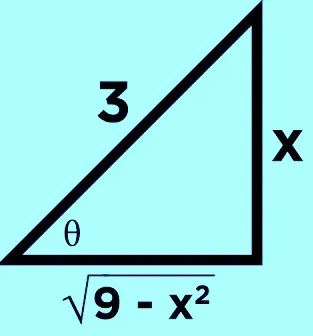Integrating trigonometric expressions involves solving trigonometric expressions that contain trigonometric functions. These functions are periodical. They denote the relationship between the angle and the sides of a right-angled triangle.

Examples of trigonometric functions includes:
- sine
- cosines
- tangents
- secants
- cosecants
- cotangents
There are various techniques used to integrate mathematical expressions with trigonometric functions. Integration of trigonometric expressions requires a mix of direct integration rules. This may includes simplification using identities, substitution, and sometimes integration by parts, depending on the form of the expression. some of the techniques includes:
some know trigonometric functions and identities
some trigonometric identities are known to transform to another specific and definite trigonometric functions after the integration process. This can be very useful during Integrating trigonometric expressions. Some examples includes:
The above expression shows that we always obtain a negative value of a cosine function. This negative value is accompanied by another constant number whenever the sine function is integrated.
in other words, integrating a cosine functions results to a positive value of a cosine function when Integrating trigonometric expressions.
(iii).∫sec2xdx=tanx+c
(iv).∫csc2xdx=−cotx+c
(v).∫secxtanxdx=−secx+c
(vi).∫cscxcotxdx=−cscx+c
2. Using trigonometric identities
by using trigonometric identities, some trigonometric expressions that could be complex to integrate becomes simplified .
When Integrating trigonometric expressions useful trigonometric identities includes:
The above identities are known as power reduction identities
3. Substitution Method
Substitution method in integration is a used to simplify an integral by making a change of variables. This transforms the integral into a simpler form Integrating trigonometric expressions. It is often used when the integrand contains a composite function, making it easier to integrate.
Substitution generally has the following steps:
- Identifying part of the integrand that can be replaced with a new variable (usually denoted by u).
- Compute the derivative of the chosen substitution with respect to x (i.e., find du). This helps in expressing dx in terms of du.
- Substitute u and du into the original integral, replacing the x-terms with the new u-terms. This aims at simplifying the integral so that it’s easier to solve.
- Perform the integration with respect to u.
- Once the integral is solved in terms of u, substitute the original expression for u back into the result to return to the variable x.
In trigonometric functions, the trigonometric ratio can have even or odd powers, which determines how they are treated during integration.
Integration of trigonometric expressions: 4. Integration by Parts
Integration by parts is a technique commonly used to integrate product of two functions. It is based on the product rule for differentiation derived from the following formula:
By applying the formula the above formula, you can reduce the complexity of the integral so that it is easier to solve.
Integration by parts may involves steps like:
- Choose two functions from the integrand, u and dv, such that the integral of v is easier to compute than the original one
- Compute du, the derivative of u.
- Compute v, the integral of dv
- Substitute u, dv, du, and v into the integration by parts formula.
- If the resulting integral is easier to evaluate, solve it. If not, apply integration by parts again
Integration of trigonometric expressions: Trigonometric Substitution
This is used when the integrand involves square roots and trigonometric functions. consider the integral:
An integral that looks like the above expression can be solved first by substituting x for sinθ such that x -sinθ = 0.
that is: x= sinθ
Integrating Even powers of sine and cosine
Integrating even powers of sine and cosine involves simplifying the integral of expressions where the powers of sine n is an even integer. These integrals can often be simplified using power reduction identities.
When powers of a trigonometric ratios are even, the double angle identities becomes very useful. These identities reduce the even powers of sine and cosine to sums of trigonometric functions of lower powers. This process makes the integration easier. These identities includes:
Example problem on trigonometric substitution
now we expand the binomial product to have:
Therefore:
simplifying we finally have:
Example2
solve : ∫sin24θdθ
solution
using double angle identities;
remember the identity:
hence
integrating we find :
Solving Integrating trigonometric expressions with odd powers
while integrating this kind of trigonometric expressions, we use trigonometric identity which states that:
cos2θ+sin2θ=1

consider the integral:
∫sin5θdθ
we split the operation sin5θ into sin4θ(sinθ).
thus:
but sin4θ = (1-cos2θ)2 from the identity stated earlier.
Expanding:
(1−cos2θ)2=(1−2cos2θ+cos4θ)θdθ
it follows that:
∫sin4θsinθdθ=∫(1−cos2θ)2sinθdθ
=∫(1−2cos2θ−cos4θ)sinθdθ
=∫(sinθ–2sinθcos2θdθ+sinθcos4θ)dθ
=∫sinθdθ–2∫sinθcos2θdθ+∫sinθcos4θdθ
remember the identity:
hence
similarly:
hence,
In general, integrating even power of sine and cosine constitutes the following procedure:
- If the integrand contains an even power of sine or cosine, use the corresponding power reduction identity. This will simplify the expression.
- After applying the identity, the integral often becomes easier to solve. This is because the powers of sine or cosine are reduced to terms involving cos(2x) or constants. These terms can be integrated straightforwardly.
- Repeat where necessary: If higher powers of sine or cosine appear, you may need to apply the power reduction identity. You might have to do this multiple times.
Example 3
solve: ∫cos3θdθ
solution
hence:
and
Example 4
solve:
∫tan3θdθ
solution
incase of tanθ, we use the identity :
1+tan2θ=sec2θ
∫tan3θdθ=∫tan2θtanθdθ=∫(sec2θ−1)tanθdθ
∫(sec2θ−1)tanθdθ=∫(sec2θtanθ−tanθ)dθ
=∫sec2θtanθdθ−∫tanθdθ
we can use integration by substitution to solve
∫sec2θtanθdθ
let u = tanθ
hence du = sec2θdθ
and
and
∫tanθdθ=ln|cosθ|+c
hence
Example 4
Solve the integral ∫sec62xdx
solution
∫sec62xdx=∫sec42xsec2xdx=∫(1+tan2x)2sec22xdx ——(i)
that is:
Expanding the equation (i) above:
which results to:
consider the integral;
let u=2x then:
Therefore: du=2dx
consider the expression:
let u = tan2x
du = 2sec22xdx
dx=du2sec22x
the expression therefore becomes:
Using the same method and procedure:
combining the results of (ii), (iii) and (iv), the integral becomes;
Integration of trigonometric expressions: Multiple angles identities
Multiple angle identities are trigonometric identities that express trigonometric functions of multiple angles (such as 2θ, 3θ, etc.) in terms of simpler functions of a single angle θ. These identities are helpful in simplifying expressions involving trigonometric functions of multiple angles.
Some common multiple angles includes:
- sin(A+B) +sin(A-B) = 2sinAcosB
- cos(A+B) + cos(A-B) = 2cosAcosB
- cos(A-B)-cos(A+B) = 2sinAsinB
Example 6
work out: ∫sin5θcos3θdθ
the solution to this would be:
this follows from: sin(A+B) +sin(A-B) = 2sinAcosB
in our case: A=5θ and B = 3θ
hence:
therefore:
it follows that:
Example 2
work out: ∫sin3θcos2θdθ
you can proceed as follow:
from double angle identities:
therefore
but
Related Topics
- Introduction to surds
- Integration by substitution
- Rationalizing a denominator
- Breaking integral into Reduction Formulae2
- Simplifying surds:3 Easy approach
- What Variance? 1 easy Simple Guide
- Measures of dispersion: Easy and concise approach
- precisely Integrating trigonometric expressions 1
- Easy Integration 4: partial fractions
- Breaking integral into Reduction Formulae 2
- Simple understanding of Stationary Points.

